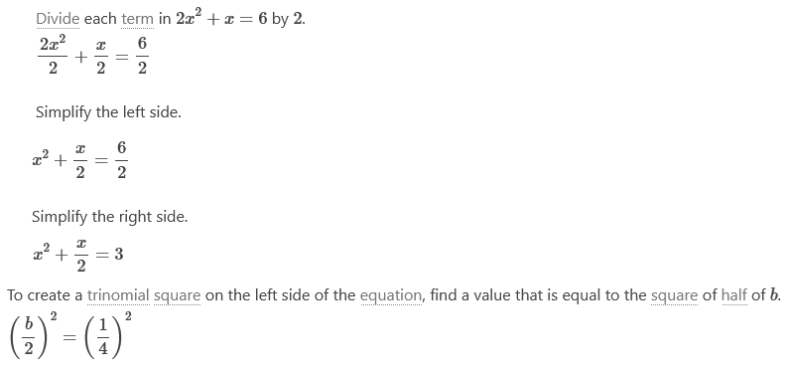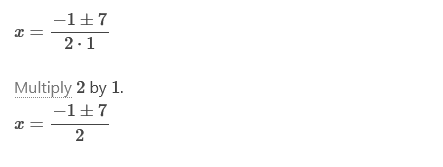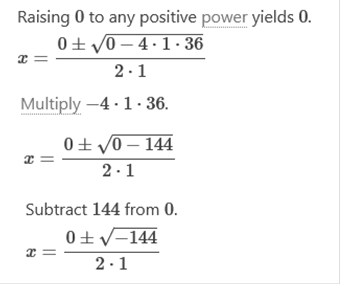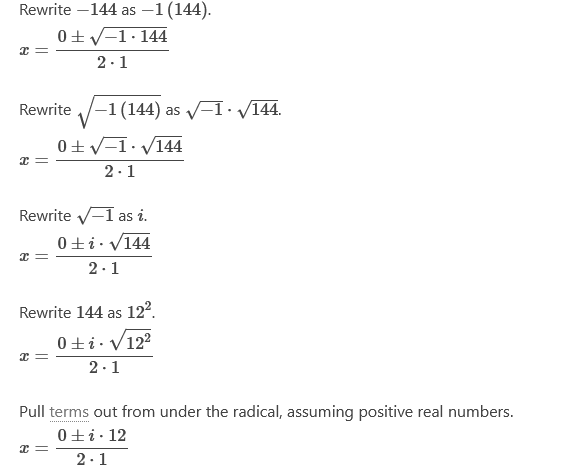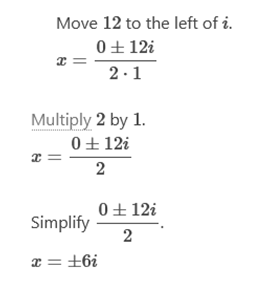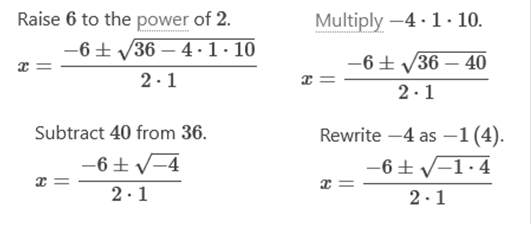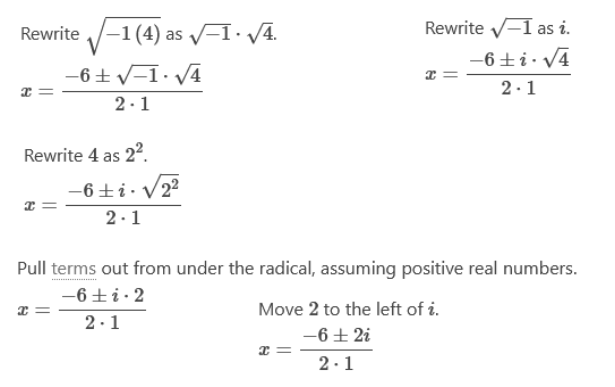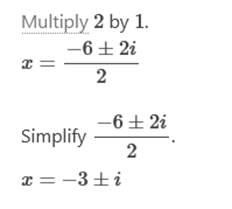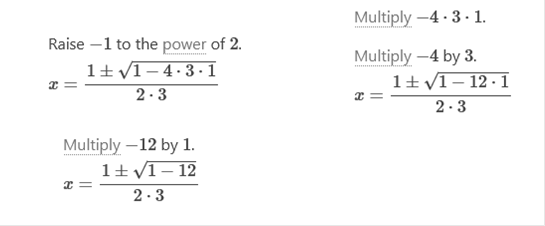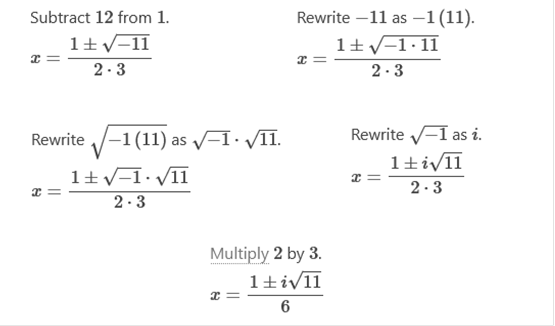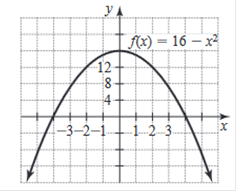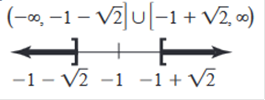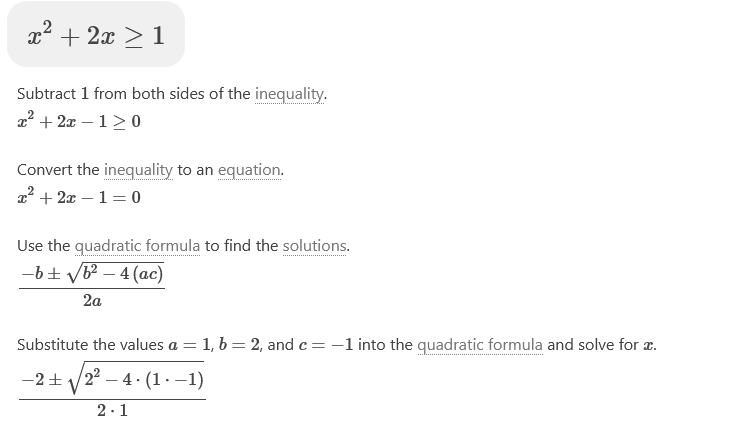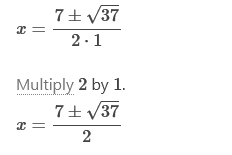|
Accounting | Business | Computer Science | General Studies | Math | Sciences | Civics Exam | Help/Support | Join/Cancel | Contact Us | Login/Log Out Intermediate
Algebra Chapter 1 2 3 4 5 6 7 8 9 10 11
Elementary and Intermediate Algebra Chapter 10: Quadratic Equations, Functions, and Inequalities Calculate the value of b2 – 4ac, and state how
many real solutions the equation has.
2x2 – 3x + 2 = 0
0 real
solutions Explanation The value of b2 – 4ac is called the “discriminant” of a quadratic equation. The discriminant of a quadratic is the expression inside the radical of
the quadratic formula. b2 − 4(ac) a b c 2x2 – 3x + 2 = 0 Notice the positions of a, b, & c in the formula first!!! b2 − 4(ac) is the formula. Substitute in the values of a, b, and c. (−3)2 − 4(2 ⋅ 2) Evaluate the result to find the discriminant. (−3)2 = 9 − 4(2 ⋅ 2) = -16 Subtract 16 from 9. 9 – 16 = -7 −7 Since the discriminant, -7, is negative, there are 0 real solutions. If the discriminant, (b2 −
4(ac)) > 0, it has 2 Real Solutions If the discriminant, (b2 −
4(ac)) = 0, it has 1 Real Solutions If the discriminant, (b2 −
4(ac)) < 0, it has 1 Real Solutions Calculate the value of b2 – 4ac, and state how
many real solutions the equation has. -3x2 + 5x – 1 = 0 13 2 real
solutions Explanation The discriminant of a quadratic is the expression inside the radical of
the quadratic formula. b2−4(ac) Substitute in the values of a, b, and c. 52 − 4(−3 ⋅ −1) 25 − 12 Subtract 12 – 25 = 13 13 > 0, so, it has
2 Real Solutions Calculate the value of b2 – 4ac, and state how
many real solutions the equation has. 4x2 – 4x + 1 = 0 0 1 real
solutions Explanation b2−4(ac) Substitute in the
values of a, b, and c. (−4)2
−4(4 ⋅ 1) (−4)2 =
16 −4(4 ⋅ 1) = -16 16 − 16 0 0 = 0, so, it has 1 Real
Solutions Solve by using the quadratic formula: 2x2 +
5x – 3 = 0 -3, Check Answer http://coursesavior.com/free/quadratic-equation-solver/ Explanation Use the quadratic formula to find the solutions.
Solve by using the quadratic formula: x2 +
6x + 6 = 0 x = -3
Simplify the numerator.
Solve by competing the
square: x2 + 10x + 25 = 0 x = -5 Check Answer http://coursesavior.com/free/quadratic-equation-solver/ Explanation
Solve by competing the square: 2x2 + x
– 6 = 0 x = -2,
Check Answer http://coursesavior.com/free/quadratic-equation-solver/ Explanation
Solve by any method: x(x
+ 1) = 12 x
= 3, −4 Explanation Move all terms to the left
side of the equation and simplify. Simplify the left side. x2 + x = 12 Subtract 12 from both sides of the equation. x2 + x – 12 = 0
Simplify. Simplify the numerator.
The final answer is the combination of both solutions. x = 3, −4 Solve by any method. a4 – 5a2 + 4 = 0 a = Explanation −4, −1 Write the factored form using these integers. Since both terms are perfect squares, factor using the
difference of squares formula,
a + 2 = 0, a – 2 = 0, a + 1 = 0, a – 1 = 0
Set a + 2 equal to 0 and solve for a. a = −2 The final solution is all the values that make (a + 2) (a −
2)(a + 1)(a − 1) = 0 true. Solve by any method: x – 2 -
8 11, 27 Explanation To remove the
radical on the left side of the equation, square both sides of the equation. Simplify each side
of the equation. 64x – 128 = x2
+ 26x + 169 Solve for x - Since x is on the right side of the equation, switch the sides so it is on the left side of the equation. x2 + 26x + 169 = 64x − 128 Move all terms containing x to the
left side of the equation. x2
− 38x + 169 = −128 Add 128 to both sides of the
equation. x2 − 38x + 169
+ 128 = 0 Add 169 and 128. x2 − 38x + 297 = 0 Factor x2 − 38x + 297 using
the AC method. (x−27) (x−11) = 0 If any individual factor on the left
side of the equation is equal to 0, the entire expression will be equal
to 0. x – 27 = 0 x – 11 = 0 Set x – 27 equal
to 0 and solve for x. x = 27 Set x – 11 equal
to 0 and solve for x. x = 11 The final solution is all the values
that make (x−27) (x−11)= 0 = x = 27, 11 Find
the complex solution to the quadratic equation x2 + 36 = 0
Explanation
Simplify. Simplify
the numerator.
Find
the complex solution to the quadratic equation x2 + 6x + 10 = 0 x = −3 ± i
Simplify. Simplify the numerator.
Find
the complex solution to the quadratic equation 3x2 - x + 1 = 0
x
= Explanation
Simplify. Simplify
the numerator.
Graph
the parabola. Identify the vertex, intercepts, and the maximum or minimum
y-value: f(x) = 16 – x2 Vertex (0,
16) Intercepts
(0, 16), (-4, 0), (4, 0) Maximum
value 16
Explanation
List the intersections. x-intercept(s): (4, 0), (−4, 0) y-intercept(s):
(0,16) The maximum of a quadratic function occurs at x = If a is negative the maximum value of the function
is f ( fmaxx = ax2 + bx + c occurs at x = We must find the value of x = Substitute in the values of a and b
Now we move the negative one from the denominator of Rewrite −1 ⋅ 0 as −0 x = − (−0), so x = 0 We are looking for the maximum y value, and found x, so now we: Evaluate f (0). Replace the variable x with 0 in the expression. f (0) = 16 −(0)2 minimum y-value = 16 Graph We use the information above to graph the parabola. We use a, h, and k. we have all of them
already. Glance up and you will see 2a, so a = -1. h and k are (0, 16), so Graph
the parabola. Identify the vertex, intercepts, and the maximum or minimum
y-value: g(x) = x2 – 3x x-intercept(s):
(0,0), (3,0) y-intercept(s):
(0,0) Explanation Set x−3 equal to 0 and solve for x. Add 3 to both sides of the equation x=3 Find the y-intercepts. Write a quadratic equation that has each given pair of
solutions: -4, 6 x2
– 2x – 24 = 0 Explanation Apply the
distributive property. x (x − 6)
+ 4(x − 6) = 0 Apply the
distributive property. x . Simplify and combine
like terms. Simplify each term. x2
− 6x + 4x – 24 = 0 Add −6x and 4x. x2 − 2x – 24 = 0 Write a quadratic equation that has each given pair of
solutions: -5i, 5i x2 + 25 = 0 x = −5i and x = 5i
are the two real distinct solutions for the quadratic equation, Solve the
inequality. State and graph the solution set: w2
+ 3w < 18 (6, -3) Explanation The solution
consists of all of the true intervals. −6 < w < 3 Solve the inequality. State and graph the
solution set: x2 + 2x ≥
1. Explanation
Solve the inequality. State and graph the
solution set: x2 – 6x + 13 > 0 (−∞,∞)
Explanation Convert the inequality to an equation. x2 − 6x +
13 = 0
Simplify. x = 3 ± 2i Solve the inequality. State and graph the
solution set: x – x2 ≥
4
Explanation
Simplify, Identify the leading
coefficient. Find the exact solution to the problem. A new computer can process a company’s
monthly payroll in 1 hour less time than the old computer. To really save time, the manager used
both computers and finished the payroll in 3 hours. How long would it take the new
computer to do the payroll by itself?
Explanation 1/ (x-1) + 1 / x = 1/3 find the LCM x(x-1). Simplify
the numerator.
Decimal Form: Find the exact solution to the problem. The height in feet for a ball thrown
upward at 48 feet per second is given by s(t) = -16t2 + 48t, where t is the time in seconds after the ball is tossed. What is the maximum height that the
ball will reach? 36 feet Explanation
s(t)= -16t2+ 48t is a
"quadratic" - a parabola that
opens downwards
The max height will be at the vertex. The "time" (t) when it reaches the max is the "axis of symmetry": t = -b/(2a) = -48/(2(-16)) = -48 / (-32) = 1.5 seconds. Height, then is found by plugging the above back into: s(t)= -16t2 + 48t s(1.5)= -16(1.5)2 + 48(1.5) s(1.5)= -16(2.25) + 48(1.5) s(1.5)= -36 + 48(1.5) s(1.5)= -36 + 72 s(1.5)= 36 feet |
| Home |
Accounting & Finance | Business |
Computer Science | General Studies | Math | Sciences |
Civics Exam |
Everything
Else |
Help & Support |
Join/Cancel |
Contact Us |
Login / Log Out |









